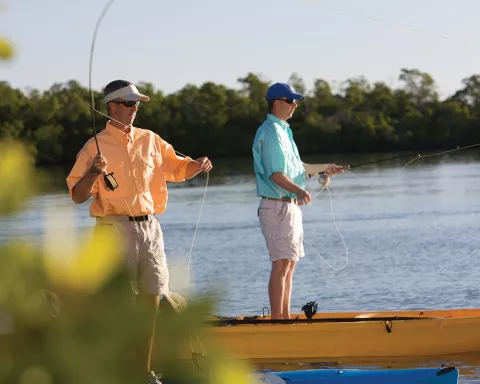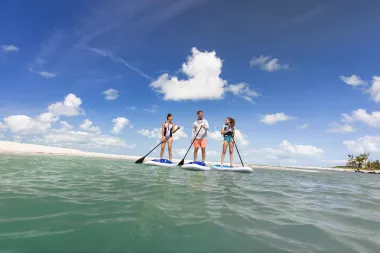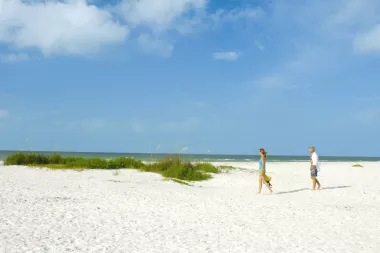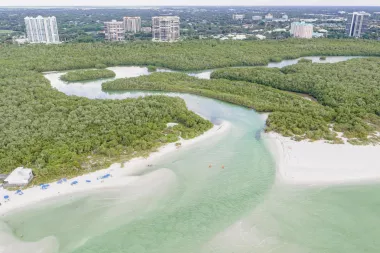A Quiet Adventure: Kayak Fishing on Florida’s Paradise Coast

Looking for some peace? Then paddle a kayak through Ten Thousand Islands or Rookery Bay, where all the sights and sounds come from nature. Want to have some fun with your peace? Then get on a kayak rigged for fishing and head out in search of tarpon, redfish, snook, and other hard-fighting critters.
Kayak fishing has really taken off on Florida’s Paradise Coast. You don’t need a boat with a motor, or even a dock from which to launch. You can bring your own kayak along for your visit, or rent a fishing kayak here. Either way is far cheaper than chartering a powerboat. As far as launching, all you need is an open piece of land with access to water.
You get a more intimate connection with nature in a kayak. The only sound you make is the gentle whoosh of the paddle. What’s more, you can get as close to the mangroves as you want. [NOTE: HIGHLIGHT SHOULD LINK TO FISHING THE MANGROVES ARTICLE WHEN LIVE] That’s where most of the game fish hang out. Mangroves are those thick clusters of trees and shrubs that you see on the coastlines throughout the Paradise Coast. They grow mostly around shallow inland waters, which makes a kayak such an ideal vessel. Best of all, fishing in these sleek, human-powered boats has almost zero impact on the environment.
The sounds and sensations of the catch are more intense in a kayak — the fish strikes, then a sudden splash, then the whizz of your reel. If the fish jumps out of the water you’ll hear an even bigger splash, followed by a more urgent cranking sound as you reel in your quarry. If you’re lucky enough to get it beside the boat, there’s nothing more satisfying than the flutter of your catch in your net.
None of the above is guaranteed, by the way – you’ve got to know what you’re doing. Of course, the most foolproof way to have a great day of kayak fishing on Florida’s Paradise Coast is to hire a guide (a few operators are listed below).
Whether you fish by yourself or with a guide, following are some key tips straight from some of the foremost fishing experts on Florida’s Paradise Coast. And don’t worry, we won’t get too deep in the weeds.

Eyes on the Tides — Kayak fishing in the mangroves is more attuned to tides than seasons. In a high tide, you’ll see the water receding into the root system. Many predator fish — the ones you’re after — back themselves into the roots in an attack position waiting for prey to swim by. At high tide, you’ll get the most bites within two feet of those roots. The idea is to cast your bait as closely to the mangroves as possible. As the tide drops, fish move out of the roots and position themselves two to three feet from the mangrove shoreline.
The general consensus is you’ll get more bites at high tide than at low. Additionally, some experts value the incoming tide, when moving water is pushing baitfish into the mangrove areas. However, fishing at low tide is not a waste of your time. The shallower water allows anglers to see intricate root systems, prime hiding spots for fish. At low tide, it’s best to find deeper areas, where fish are more likely to congregate.
The Strike Zone — The prime casting area extends zero to 10 feet off the shoreline. Depending on the tide, you’ll want to cast into the most fertile zones.
Keep a Proper Distance — Even stealthily paddling a kayak can spook fish, so it’s not advisable to bring your boat right up to shoreline. A rule of thumb is to cast from 20 to 30 feet away — again, depending on the tide.
Consider Lures — There is no firm consensus on whether artificial lures or live bait are preferable for kayak fishing the mangroves, but experts agree that you can have a wildly productive outing with lures. Using them tends to make you more nimble.
Casting is Key — As you might expect, flicking your wrist and shooting that lure or bait into the appropriate strike zone is an acquired skill. Consider practicing a little first. And please don’t get frustrated if you overshoot the zone and your hook ends up tangled in the mangroves. It happens to even the best anglers.
Use light tackle — You don’t want fishing to be cumbersome in a kayak, so spinning rods and smaller hooks and weights are preferable. Avid kayak fisherman Matt Kitchen recommends a rod of 6-feet 6-inches or longer. The additional length helps control a fish and maneuver it around the kayak and other tangle hazards.
Cover Lots of Ground — When fishing an area like Ten Thousand Islands, mangrove islets are often clustered closely together. So if one spot isn’t producing results, paddle off and try another. Experts cite the 90/10 rule — 90 percent of the fish are in 10 percent of the water. Keep moving to find that 10 percent. Paddling is part of the fun.
Use Your Eyes — Look for birds, baits and boils – what experts call the Three B’s. Birds go where the fish are. Busy (and visible) schools of baitfish are choice hunting grounds for sportfish. A boil is where a school of fish pushes smaller fish onto the surface and attacks them. It makes quite a commotion, and is easily seen.

Look for the points and coves in the mangroves. Points are where the trees jut out and coves are indentations in the tree line. These are the areas on the shoreline that are most likely to contain sportfish. Look for mangrove stands with coastlines that are more jagged than flat.
Consider Catch-and-Release — Florida has a vast array of strict rules about what part of the year you can keep certain fish (like snook) and how small or big they can be (called slot limits). Unless you’re staying in a place that has a kitchen or grill, don’t worry about keepers. Simply reel in a fish, net it, remove the hook, take a photo if you wish, and gently return it to the water. That ultimately means more fishing and catching than measuring and stowing. (Hey, if you were looking forward to a fresh shore dinner, there are plenty of restaurants on Florida’s Paradise Coast that will serve you the freshest fish around!)
Here are a few companies that offer guided kayak fishing excursion:
Paddle Naples, Naples Fishing Adventures, Everglades Kayak Fishing, Everglades Area Tours
If you’re interested in keeping your catch, click here for detailed regulations from the Florida Fish and Wildlife Conservation Commission.
And as a reminder, Florida visitors are required to have a fishing license, with some small exceptions. Click here for details.
Explore More of Paradise Coast

Guide to Family Gatherings in Naples, Marco Island and the Everglades

Find Your Beach in Naples and Marco Island

Explore Natural Beauty at Keewaydin Island
